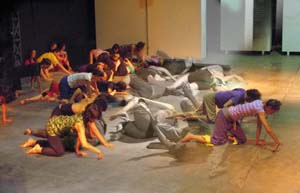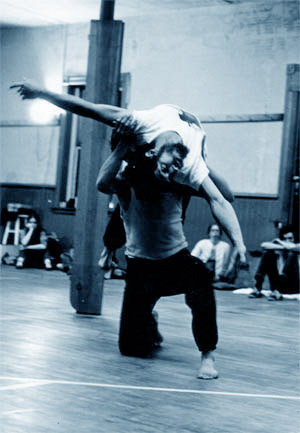Writings on Dance:
The Movement of Attention
What is Release Technique?
After Gertrude Stein: On improvisation and what my teachers taught me
Contact Improvisation:
A question?
Contact Improvisation:
What happens?

Simone Forti
Photo by: Daniel Lepkoff, 2000
While working with vision and attempting to organize my observations into repeatable forms, I stumbled upon the phrase "The movement of attention". As it turns out, this simply phrase is a description of a pervasive process: the physical activity of being present. If the plie is a basic and constantly practiced exercise for the ballet dancer, a preparation for all other more complex choreographies, then "the movement of attention" is the plie of my work.
Daniel Lepkoff
copyright©Movement Research & Daniel Lepkoff/December 2005

Lepkoff Workshop: Rosario, Argentina Feb. 2008
Photo by: Sakura Shimada
In the summer of 1999 Movement Research was planning an issue of "The Performance Journal" focusing on Release Technique. Release Technique has significantly shaped my viewpoint and path as a dancer. My initial orientation and entry into dance was with Mary Fulkerson and others, who in the early 1970's were researching,
mapping, and defining this new work. As time would have it, this original work has mutated, being adpated and incorporated into more current dance class formats. I had a strong desire to contribute something that would share my understanding of the seminal ideas and original intention of the work I did with Mary Fulkerson in the early 70's.
Daniel Lepkoff
copyright©Movement Research & Daniel Lepkoff/March 2005
"Improvisation" has not itself been a central subject of my dance work. Rather, "improvisation" presents itself as the obvious canvas upon

Photo by: Rebecca Lepkoff, 1976
which my particular interests and questions about movement can live; an interest in the imagination acting through the body, in the composition of our movement as we respond to, survive in, and navigate through our environment. At some point the word "improvisation" took on the aspect of a label, whether for an attractive alternative or a marginal ghetto, it continues to be a label that cannot be avoided. In this short piece I imitate Gertrude Stein's play with syntax to think out loud, seeking to make a peace with the current usage of the word "improvisation".
Daniel Lepkoff
copyright©Contact Quarterly & Daniel Lepkoff/March 2005

Daniel Lepkoff & Steve Paxton
Photo by: Stephen Petegorsky, 1978
In June of 2008, at CI36, a celebration of the 36th anniversary of Contact Improvisation,
I sat on a founders panel together with Nita Little, Steve Paxton, and
Nancy Stark Smith. I don't consider myself a founder of Contact Improvisation.
For me that is Steve's unique position. I was a bit
uncomfortable. So be it.
As we were speaking about Contact Improvisation the phrase "the duet form" repeatedly rang
in my ears. Something was wrong.
I suddenly felt my mind working too fast for me to compose well formed sentences
around my thoughts. I remember managing to say that I did not agree with "the duet form", that
Contact Improvisation only looks like a duet when viewed from the outside,
but for the person inside of the dance it is a solo.
Feeling the presentation of my own ideas was pitifully incomplete I went home and drafted
a first version this writing.
Daniel Lepkoff
CONTACT IMPROVISATION:
What happens when I focus my attention on the sensations of
gravity, the earth, and my partner?
copyright©ContreDanse & Daniel Lepkoff / Dec. 1998
Still from the video: "Chute (c)1979" available through:
Videoda